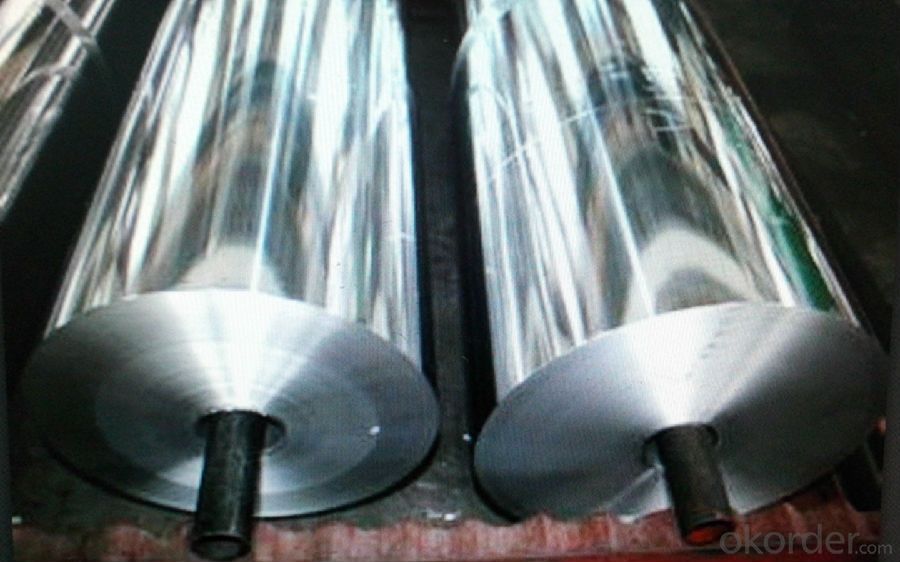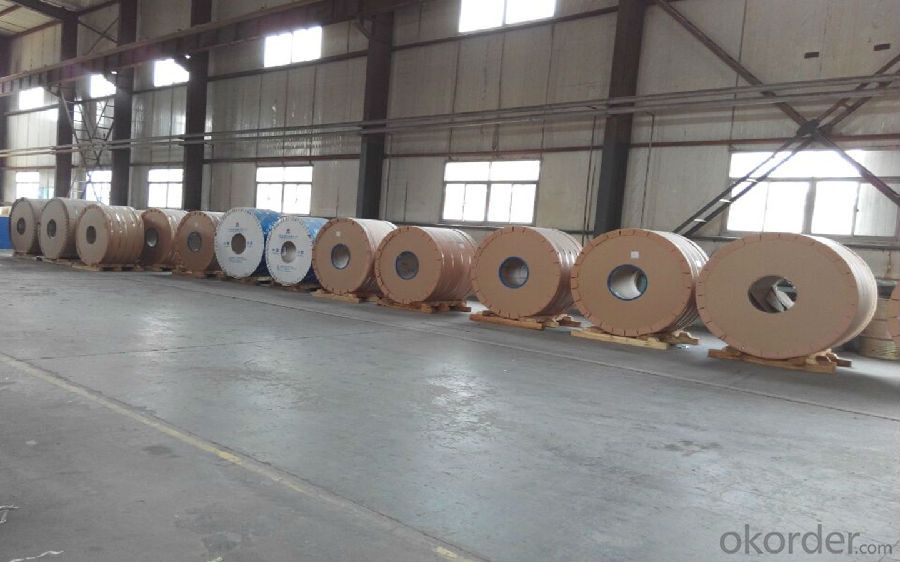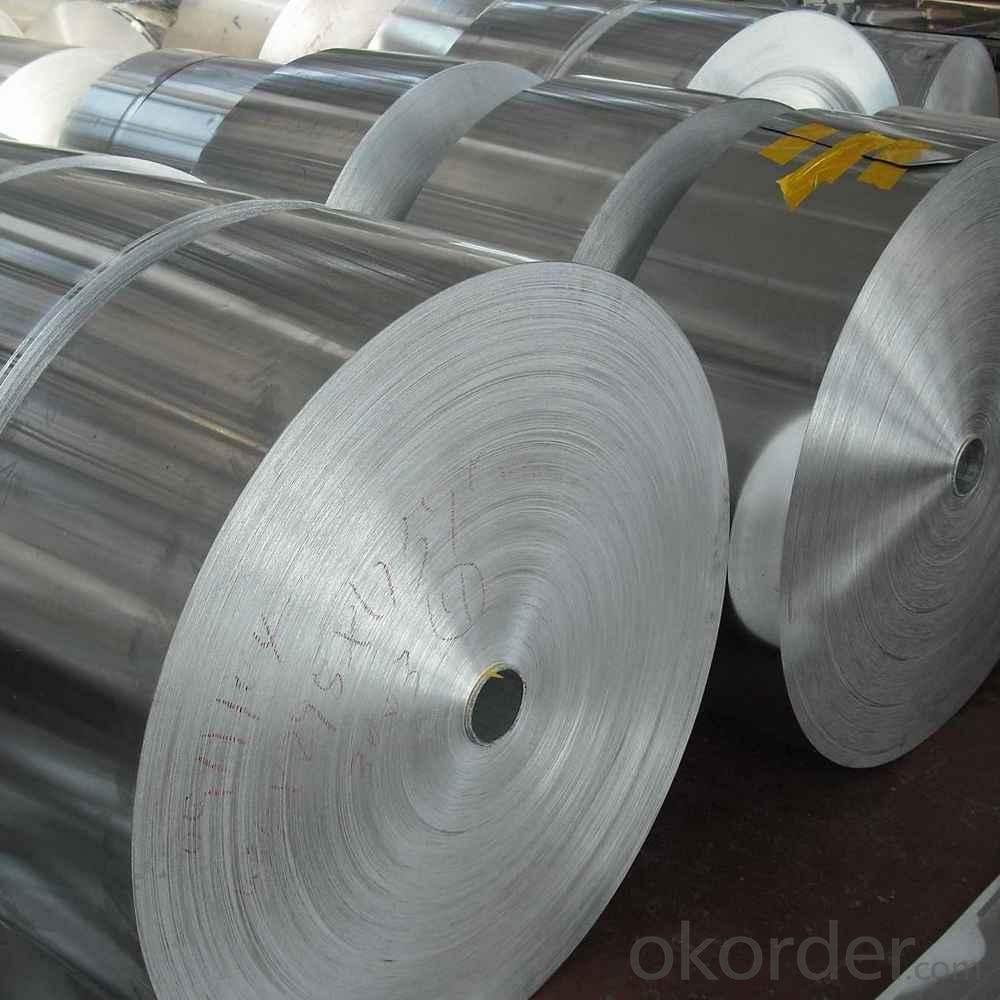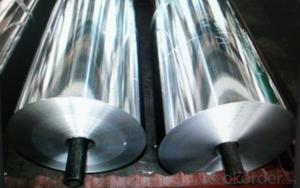Kitchen Use Household Aluminium Foil Jumbo Roll
- Loading Port:
- Shanghai
- Payment Terms:
- TT OR LC
- Min Order Qty:
- 5 m.t.
- Supply Capability:
- 9000 m.t./month
OKorder Service Pledge
OKorder Financial Service
You Might Also Like
Item specifice
Product Details :
1 ) .Alloy : 8011 /1235 O- temper
2 ) .Color : Silver (one side is bright and the other side is matte)
3 ) .Thickness: 9mic, 10mic, 11mic, 12mic, 13mic, 14mic, 15mic, 18mic, 20mic, 24mic, 30mic.
4 ) .Width: 280mm; 290mm, 300mm, 304mm; 450mm; 457mm; 600mm.
5 ) .Length: 1m, 7.5m, 8m, 9m, 10m, 15.62m, 22.86m, 30m, 50m, 80m , 100m, 150m, 300m, 900m.
Note:any size and packing color box can be customized.

6 ) . Paper Core options:
can be light or heavy according to customer's requirements; the color could be brown or white;
7 ) .The Cutters:
Three common kinds of cutters: Steel Cutter; Plastic Saw Blade; Paper Saw Blade.
You can choose whether you need or not.
8 ) . Package Details:
Each roll is packed with an individual packing, and usually there are three kinds of common packaging,
(1). the color box (with /without blade) ; (2). the PP bag with painting; (3).the shrinking package.
Carton/Box.2/4/6/9/12/16/24/36/50/100 rolls per carton.
Feature:
Our products can be produced according to China GB Standards and the ISO series standards of theInternational Standards Organization,JIS and ASTM.
Kind attention:
Specifications can be customized according to the customer’s requirements.


- Q:What is the modulus of elasticity for aluminum sheets?
- The modulus of elasticity for aluminum sheets typically ranges between 69 GPa and 73 GPa.
- Q:What are the different joining methods for aluminum sheets?
- There are several different joining methods for aluminum sheets, each with its own advantages and considerations. Some of the common joining methods for aluminum sheets include: 1. Welding: Welding is a popular method for joining aluminum sheets. It involves melting the aluminum sheets and fusing them together with the help of a filler material. Welding can be done using various techniques such as gas tungsten arc welding (GTAW), gas metal arc welding (GMAW), or laser welding. It provides strong and durable joints, but it requires skilled labor and can be time-consuming. 2. Adhesive bonding: Adhesive bonding is another method commonly used for joining aluminum sheets. It involves applying a specialized adhesive or glue to the surfaces that need to be joined. Adhesive bonding offers several advantages such as excellent corrosion resistance, uniform distribution of stress, and the ability to join dissimilar materials. However, it requires proper surface preparation and can be affected by temperature and humidity. 3. Mechanical fastening: Mechanical fastening involves using various mechanical fasteners such as bolts, screws, rivets, or clips to join aluminum sheets. This method is relatively simple, cost-effective, and allows for easy disassembly if required. However, it may create stress concentrations around the fasteners, and the joints may not be as strong as those created by welding. 4. Friction stir welding: Friction stir welding is a relatively new joining method that is gaining popularity for aluminum sheets. It involves rotating a non-consumable tool along the joint line, generating friction and heat that softens and joins the aluminum sheets. Friction stir welding offers benefits such as high joint strength, low distortion, and a defect-free weld. However, it requires specialized equipment and is limited to certain sheet thicknesses. 5. Clinching: Clinching is a cold joining method that involves deforming the aluminum sheets using a punch and die without melting them. The sheets are pushed together under high pressure, creating a mechanical interlock. Clinching is a fast and cost-effective joining method that does not require additional materials, but it may result in visible deformation on the surface. It is essential to consider factors such as joint strength, corrosion resistance, aesthetics, production cost, and specific application requirements when choosing a joining method for aluminum sheets. Each method has its own advantages and limitations, so selecting the most suitable technique depends on the specific needs of the project.
- Q:What are the different types of patterns available for textured aluminum sheets?
- There are several different types of patterns available for textured aluminum sheets, each offering a unique visual appeal and functionality. Some of the most common patterns include: 1. Diamond pattern: Also known as tread plate or checker plate, the diamond pattern features small raised diamonds on the surface of the sheet. This pattern offers excellent slip resistance, making it ideal for applications where traction is important, such as ramps, stairs, or industrial flooring. 2. Stucco pattern: The stucco pattern resembles a textured wall or ceiling finish, with raised ridges that create a rough and bumpy surface. This pattern is often used for decorative purposes, adding depth and visual interest to architectural elements like walls, ceilings, or furniture. 3. Hammered pattern: As the name suggests, the hammered pattern mimics the look of a surface that has been hammered by hand, creating a dimpled and uneven texture. This pattern is commonly used in architectural applications, such as wall panels, backsplashes, or decorative accents, to add a rustic and artistic touch. 4. Brushed pattern: The brushed pattern features long, uniform lines that are created by brushing the surface of the aluminum sheet with a wire brush. This pattern offers a sleek and modern appearance, making it popular for applications like kitchen appliances, signage, or interior design elements. 5. Perforated pattern: Unlike the previous patterns, the perforated pattern involves creating small holes across the surface of the aluminum sheet. This pattern is often used in applications that require ventilation, sound absorption, or decorative effects. It can be found in areas such as speaker grills, filters, or façades. These are just a few examples of the different types of patterns available for textured aluminum sheets. The choice of pattern will depend on the specific requirements of the project, including aesthetics, functionality, and durability.
- Q:when aluminum metal undergoes a combination reaction with O2(g)
- Aluminium metal combines with the oxygen from the air on heating to form aluminium oxide. The reaction can be represented using a balanced equation as 4 Al (s) + 3O2(g) = 2Al2O3(s)
- Q:Are aluminum sheets suitable for automotive heat shields?
- Yes, aluminum sheets are suitable for automotive heat shields. They have excellent thermal conductivity and high melting point, making them effective in dissipating heat and protecting sensitive components from excessive temperature. Additionally, aluminum is lightweight and corrosion-resistant, which are desirable qualities for automotive applications.
- Q:A 0.2412 gram sample of aluminum ore was dissolved in a dilute mineral acid. The solution was treated with an excess of sodium oxalate. The resultant aluminum oxalate precipitate was filtered, washed and redissolved in mineral acid, then titrated with 42.12 mL of 0.1098 N KMnO4. Calculate the percent of aluminum in the sample.
- determine which you do catch the Hydrogen gas in a balloon. combination Lye with water in a pitcher bottle (Coke liter bottle is huge). drop in Aluminum foil (do no longer give way) and cap off with a balloon. The balloon will fill with hydrogen. do away with the balloon, pinching the backside keeping the hydrogen; shop including Aluminum foil strips and place the balloon lower back over the precise till at last the balloon is of a sturdy length. Tie the balloon off, tape a fuse (some thing that burns slow) to the balloon, permit it bypass up interior the air. whilst the hearth its the balloon, it pops and the hydrogen + oxygen (interior the air) + spark reasons a small flash (hydrogen explosion). Do it at night for a extra advantageous view.
- Q:Are 101 aluminum sheets suitable for conductive heat transfer applications?
- 101 aluminum sheets are not appropriate for applications involving conductive heat transfer. This specific aluminum alloy, known as 101 aluminum, is commercially pure and has a low electrical conductivity. Consequently, it is ineffective at efficiently conducting heat, rendering it unsuitable for situations requiring heat transfer. Instead, it is advisable to employ alloys with higher thermal conductivity, such as 6061 or 7075 aluminum, for conductive heat transfer applications. These alloys possess superior heat transfer properties and are commonly utilized in heat sinks, heat exchangers, and other scenarios demanding efficient heat transfer.
- Q:what is the behaviour of Al2O3= aluminium oxide and SiO2= silicon dioxide when heated from room temperature to 1000 degree celcius?
- Aluminium oxide is a metal oxide and here shows it's basic properties. Silicon dioxide is a non metal oxide, so acidic Acid + base ---- salt so aluminium silicate is formed
- Q:Can aluminum be either conductive or magnitized?
- Aluminum can be conductive but not magnetized. In fact it has the ability to be a superconductor. But based on the electron spin in the last orbital it makes it Paramagnet. which means that it alone is not magnetic, but it will conform and be attracted to other magnetic fields. note that Al has such a low Paramagnetism that it will not be detectable with out sensitive equipment.
- Q:Are aluminum sheets suitable for lighting fixtures?
- Yes, aluminum sheets are suitable for lighting fixtures. Aluminum is a versatile and durable material that is commonly used in the manufacturing of lighting fixtures. It offers several advantages that make it a popular choice for this purpose. Firstly, aluminum is lightweight, which makes it easier to handle and install lighting fixtures. It is also highly corrosion-resistant, ensuring that the fixtures can withstand various environmental conditions without deteriorating or rusting over time. Additionally, aluminum has excellent thermal conductivity, allowing it to efficiently dissipate heat generated by the lighting fixtures, which helps in preventing overheating and prolonging their lifespan. Moreover, aluminum can be easily shaped and formed into various designs, making it ideal for creating aesthetically pleasing lighting fixtures. It can be extruded, rolled, or stamped to achieve different shapes and sizes, allowing for a wide range of creative possibilities. Furthermore, aluminum is a cost-effective material compared to other metals commonly used in lighting fixtures, such as brass or copper. It is readily available and has a lower price point, making it a more affordable option for both manufacturers and consumers. In summary, aluminum sheets are indeed suitable for lighting fixtures due to their lightweight nature, corrosion resistance, excellent thermal conductivity, versatility in design, and cost-effectiveness.
1. Manufacturer Overview |
|
|---|---|
| Location | |
| Year Established | |
| Annual Output Value | |
| Main Markets | |
| Company Certifications | |
2. Manufacturer Certificates |
|
|---|---|
| a) Certification Name | |
| Range | |
| Reference | |
| Validity Period | |
3. Manufacturer Capability |
|
|---|---|
| a)Trade Capacity | |
| Nearest Port | |
| Export Percentage | |
| No.of Employees in Trade Department | |
| Language Spoken: | |
| b)Factory Information | |
| Factory Size: | |
| No. of Production Lines | |
| Contract Manufacturing | |
| Product Price Range | |
Send your message to us
Kitchen Use Household Aluminium Foil Jumbo Roll
- Loading Port:
- Shanghai
- Payment Terms:
- TT OR LC
- Min Order Qty:
- 5 m.t.
- Supply Capability:
- 9000 m.t./month
OKorder Service Pledge
OKorder Financial Service
Similar products
New products
Hot products
Related keywords






























